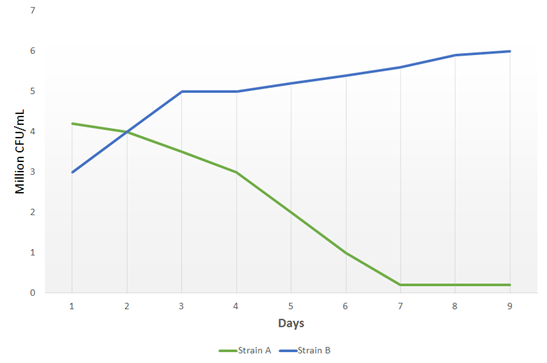WBR0632
Jump to navigation
Jump to search
| Author | [[PageAuthor::Serge Korjian M.D. (Reviewed by Serge Korjian)]] |
|---|---|
| Exam Type | ExamType::USMLE Step 1 |
| Main Category | MainCategory::Microbiology, MainCategory::Pharmacology |
| Sub Category | SubCategory::Infectious Disease |
| Prompt | [[Prompt::A researcher is studying the adaptive mechanisms of different pathogenic fungi to external stimuli. He grows 2 different strains of Candida tropicalis and observes their growth patterns after adding different antifungals to the growth media. Below is the growth curve of both strains following the addition of nystatin. Which of the following findings is likely to be observed? |
| Answer A | AnswerA::Mutation of ergosterol structure in Strain A |
| Answer A Explanation | AnswerAExp::Mutation of ergosterol in strain A would lead to increase in growth and resistance to nystatin which is not the case. |
| Answer B | AnswerB::Mutation of ergosterol structure in Strain B |
| Answer B Explanation | AnswerBExp::Strain B shown the response of resistant Candida to nystatin with continued growth. The source of resistance to nystatin would be a mutation of ergosterol structure given the |
| Answer C | AnswerC::Mutation of lanosterol structure in Strain B |
| Answer C Explanation | AnswerCExp::Lanosterol is a precursor for the production of ergosterol. Mutations of lanosterol are not associated with antifungal resistance. |
| Answer D | AnswerD::Mutation of lanosterol structure in Strain A |
| Answer D Explanation | AnswerDExp::Lanosterol is a precursor for the production of ergosterol. Mutations of lanosterol are not associated with antifungal resistance. |
| Answer E | AnswerE::Mutation of B-glucan |
| Answer E Explanation | AnswerEExp::B-glucan is a component of the fungal cell wall. Echinocandins such as caspofungin and micafungin inhibit the synthesis of B-glucan. Mutations of B-glucan are not associated with antifungal resistance. |
| Right Answer | RightAnswer::B |
| Explanation | [[Explanation::The mechanism of action of nystatin closely resembles that of amphotericin B. It binds to ergosterol molecules, which are major components of the fungal cell membrane. This leads to pore formation in the cell membrane causing potassium leakage and eventual fungal cell death. In the curve depicting the growth of strain B of Candida tropicalis, the continued growth despite the addition of Nystatin can be explained by a structural mutation in the ergosterol molecule leading to resistance to the effects of Nystatin. The curve of strain A shows a decrease in growth compatible with sensitivity to Nystatin. Educational Objective: Nystatin shares the same mechanism of action of amphotericin B. It binds to ergosterol molecules in the fungal cell membrane leading to pore formation and cell death. |
| Approved | Approved::Yes |
| Keyword | WBRKeyword::Lanosterol, WBRKeyword::Ergosterol, WBRKeyword::Antifungals, WBRKeyword::Nystatin |
| Linked Question | Linked:: |
| Order in Linked Questions | LinkedOrder:: |
